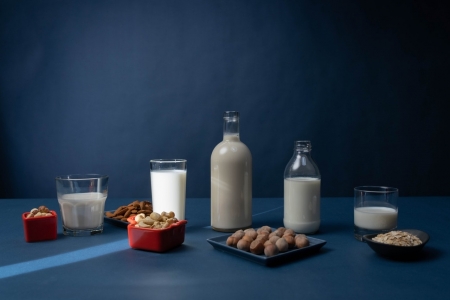Plant-Based Beverages: Rising Through the Ranks

If you’ve been inside a grocery store lately, you may have noticed the ever-expanding options on the shelves for milk alternative products. Everything from almond milk yogurt to coconut milk ice cream is becoming more popular and widely available. In fact, according to Future Market Insights (FMI) analysis, worldwide sales of non-dairy milk alternatives doubled between 2016 and 2020, and it doesn’t look like the trend is going to end anytime soon.
What’s in a Name?
The dairy industry has vigorously objected to calling these products milks. The correct term should be botanical or plant-based beverages or more simply dairy alternatives, which also includes waters and other beverages.
Lower protein contents of most plant-based beverages is the primary concern raised by the dairy industry. Most of these beverages do not provide a good nutritional source and should never be substituted for mammalian milk in the diets of growing children. Nonetheless, they do meet the sensorial and usefulness of milk substitutes for adults seeking an alternative.
Why Plant-Based Beverages?
Originally sought out as an alternative for those with a dairy allergy or lactose intolerance, plant-based beverages provide an option for those who must avoid dairy for medical reasons. While 15-30% of the US population has a dairy intolerance, the tremendous upswing in alternative milk popularity means that more people are buying it than just those who need to.
Seeking Health
A driving force behind people’s choice to use plant-based products is health, points out Greg Paul, Ph.D., MBA, Marketing Leader, DuPont Nutrition & Biosciences. However, each person’s definition of “healthy” is different. Consuming dairy products, especially in large quantities, has been linked to health concerns such as cardiovascular disease and diabetes. Consumers view plant-based products as a healthier alternative because many are rich in antioxidants and contain ingredients that boost immunity. It’s seen as an easy way to help promote an overall healthy diet.
Supporting Sustainability
A growing interest in the environment, particularly sustainability, is the other major factor motivating people to go non-dairy. Sproud, for example, a Swedish manufacturer of milk derived from split-peas, “has made its mission to create a dairy alternative with a taste closest to milk, while having the lowest carbon footprint possible.”
Oat milk’s rise in popularity, now claiming second place in market sales behind almond milk, may be attributed in part to the oat’s reputation as an incredibly sustainable crop, using little water and helping keep weeds and soil erosion at bay.
COVID’s Lasting Impact
Concern about sustainability grew during the pandemic and is “likely to continue to be one of the factors that drives consumers’ future purchases.” For those who want to support sustainable products and companies, plant-based foods are appealing.
The pandemic has also provided people the opportunity to experiment with milk alternatives. Since many plant-based milks are shelf stable, meaning they don’t need to be refrigerated, they became more enticing than their dairy milk counterparts with foreseeable expiration dates. And in some cases early on, they were the only available option as dairy milk quickly sold out and was slow to restock.
Families are still eating at home much more than they used to, and cooking with milk alternatives brings some welcomed variety to meals. For many, the switch will endure long past the pandemic.
The Future of (Non)Dairy
Industry experts believe plant-based beverages will remain a permanent change in people’s diet and expect that sales growth of these alternatives “will outpace conventional products, supported by innovation, increased production capacity, lower retail prices, distribution gains, and consumer acceptance.”
While dairy milk’s growth remained virtually flat in 2019, according to statistics from the Plant Based Foods Association, plant-based alternatives made up 14% of the entire milk market. In 2020, four in ten adults in the U.S. live in a home where someone regularly uses dairy alternatives, even if they have to pay higher prices for them.
It’s More Than Just Almonds
As you scan the refrigerator section at any local grocer, you’ll see milk harvested from a multitude of plant-based sources: almonds, peanuts, and cashews; oats; hemp; coconuts; soybeans; and even chickpeas. Each milk source has its own nutritional profile as well as taste and texture, creating plenty of room in the market for variety. Throw in sweetened and unsweetened, flavored, and even some marketed for baristas, and it’s difficult to choose what to try next.
Emerging Trends
Flavors and textures of existing plant-based dairy alternatives continue to improve, and consumer interest in trying new products in this space continues to grow. NCFIL sees a few growing trends:
- Future generations of these products will include more mixed and/or unique botanicals.
- Many major players in this area are starting to promote products more closely resembling cow’s milk in sensory (both flavor and mouthfeel) and nutrition.
- Products are being offered in newer formats, including dried products.
- Food product developers are actively reformulating existing food compositions that typically use dairy-based ingredients and replacing them with plant-based dairy alternatives.
NCFIL: Your Plant-Based Partner
The NC Food Innovation Lab is currently working on plant-based beverages and is always looking for new partners. Reach out to NCFIL to share your ideas, collaborate on formulas, and produce test products.
- Categories: